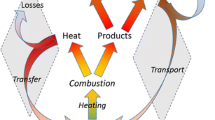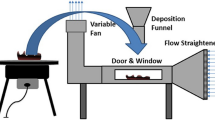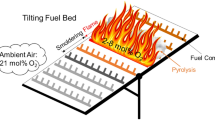Abstract
Over the past few years, numerous large-scale disasters have occurred due to wildfires at the wildland-urban interface (WUI). In these fires, spread via the transport of firebrands (burning embers) plays a significant role. Several models have been developed to describe the transport of firebrands but few, if any, are available which can provide a quantitative means to generate firebrands at the source of a fire. In this regard, a new methodology is proposed here that uses a wind tunnel to experimentally quantify the generation of firebrands from WUI fuels under different ambient conditions. The setup allows for the collection of all generated solid firebrands and major downstream gaseous species concentrations. Unique firebrand yield correlations can then be generated for each tested fuel, while also accounting for the heat-release rate, providing unique validation targets for numerical simulations. Generation of firebrands from branches of two conifers at a fixed wind speed of 4 m/s are presented to demonstrate the capabilities of this new methodology. A carbon mass balance was utilized to analyze preliminary results and understand how much of the fuel mass transitions to firebrands vs. gases. These results provide a description of the mass burning process and ultimately tie firebrand production to a time-dependent heat-release rate for initialization of firebrand transport in numerical simulations. An average firebrand yield ranging from 3–4% of initial dry mass is ultimately presented for lodgepole pine and Douglas fir. Future work is required with larger fuel sizes pertaining to real wildfire scenarios; however, the presented methodology can provide valuable data needed to initialize numerical simulations of firebrand transport, necessary for reconstruction of WUI fires and to aid in the development of mitigation strategies for the prevention of future disasters.








Similar content being viewed by others
References
Caton SE, Hakes RSP, Gorham DJ, Zhou A, Gollner MJ (2017) Review of pathways for building fire spread in the wildland urban interface part i: exposure conditions. Fire Technol 53:429–473. https://doi.org/10.1007/s10694-016-0589-z
Hakes R, Caton S, Gorham DJ, Gollner MJ (2016) A review of pathways to building fire spread in the wildland urban interface part ii: response of components and systems and mitigation strategies in the united states. Fire Technol 53:475–515
Manzello SL, Suzuki S, Gollner MJ, Fernandez-Pello AC (2020) Role of firebrand combustion in large outdoor fire spread. Prog Energy Combust Sci 76:100801. https://doi.org/10.1016/j.pecs.2019.100801
Syifa M, Panahi M, Lee CW (2020) Mapping of post-wildfire burned area using a hybrid algorithm and satellite data: the case of the camp fire wildfire in California, USA. Remote Sens 12(4):623. https://doi.org/10.3390/rs12040623
Caton-Kerr SE, Tohidi A, Gollner MJ (2019) Firebrand generation from thermally-degraded cylindrical wooden dowels. Front Mech Eng 5:1–12. https://doi.org/10.3389/fmech.2019.00032
Manzello SL, Cleary TG, Shields JR, Maranghides A, Mell W, Yang JC (2008) Experimental investigation of firebrands: generation and ignition of fuel beds. Fire Saf J 43:226–233. https://doi.org/10.1016/j.firesaf.2006.06.010
Manzello SL, Maranghides A, Mell WE, Cleary TG, Yang JC (2006) Firebrand production from burning vegetation. For Ecol Manage 234:S119. https://doi.org/10.1016/j.foreco.2006.08.160
Mell W, Maranghides A, McDermott R, Manzello SL (2009) Numerical simulation and experiments of burning douglas fir trees. Combust Flame 156:2023–2041. https://doi.org/10.1016/j.combustflame.2009.06.015
Manzello SL, Maranghides A, Shields JR, Mell WE, Hayashi Y, Nii D (2009) Mass and size distribution of firebrands generated from burning Korean pine (Pinus koraiensis) trees. Fire Mater 33:21–31
Manzello SL, Maranghides A, Shields JR, Mell WE, Hayashi Y, Nii D (2007) Measurement of firebrand production and heat release rate (HRR) from burning Korean pine trees. Proc 7th AOSFST. https://iafss.org/publications/aofst/7/108
Suzuki S, Manzello SL, Hayashi Y (2012) The size and mass distribution of firebrands collected from ignited building components exposed to wind. Proc Combust Inst 34:2479–2485
Suzuki S, Manzello SL, Lage M, Laing G (2012) Firebrand generation data obtained from a full-scale structure burn. Int J Wildl Fire 21:961–968
Hudson TR, Bray RB, Blunck DL, Page W, Butler B (2020) Effects of fuel morphology on ember generation characteristics at the tree scale. Int J Wildl Fire 29(11):1042–1051
Barr BW, Ezekoye OA (2013) Thermo-mechanical modeling of firebrand breakage on a fractal tree. Proc Combust Inst 34:2649–2656. https://doi.org/10.1016/j.proci.2012.07.066
Hudson TR, Blunck DL (2019) Effects of fuel characteristics on ember generation characteristics at branch-scales. Int J Wildl Fire 28:941–950. https://doi.org/10.1071/WF19075
McGrattan K, Hostikka S, McDermott R, Floyd J, Weinschenk C, Overhold K (2020) Sixth Edition Fire Dynamics Simulator User ’s Guide (FDS). NIST Spec Publ 1019 Sixth Edit: https://doi.org/https://doi.org/10.6028/NIST.SP.1019
Hariharan SB (2020) Experimental Investigations and Scaling Analyses of Whirling Flames. PhD Dissertation, University of Maryland, College Park
Urbanski S (2014) Wildland fire emissions, carbon, and climate: Emission factors. For Ecol Manage 317:51–60
McMeeking GR, Kreidenweis SM, Baker S et al (2009) Emissions of trace gases and aerosols during the open combustion of biomass in the laboratory. J Geophys Res Atmos 114:1–20. https://doi.org/10.1029/2009JD011836
White JP, Link ED, Trouvé A, Sunderland PB, Marshall AW (2017) A general calorimetry framework for measurement of combustion efficiency in a suppressed turbulent line fire. Fire Saf J 92:164–176. https://doi.org/10.1016/j.firesaf.2017.06.009
Drysdale D (2016) SFPE Handbook of Fire Protection Engineering, Chapter 5. Springer, Fifth Edit
Thomas JC, Mueller EV, Santamaria S et al (2017) Investigation of firebrand generation from an experimental fire: development of a reliable data collection methodology. Fire Saf J 91:864–871. https://doi.org/10.1016/j.firesaf.2017.04.002
El Houssami M, Mueller E, Filkov A, Thomas JC, Skowronski N, Gallagher MR, Clark K, Kremens R, Simeoni A (2016) Experimental procedures characterising firebrand generation in wildland fires. Fire Technol 52:731–751
Acknowledgements
This work was supported by the National Institute of Standards and Technology (NIST) under award number # 60NANB18D243. The authors would like to thank Ben Biallas, Xingyu Ren, and Sriram Bharath Hariharan for their help in experimentation as well as instrumentation and Chelsea Phillips and Sara McAllister from the USDA Forest Service for acquiring fuels. MG would also like to thank Kevin McGrattan, who suggested the current line of work, as well as Kathryn Butler, Kuldeep Prasad, Randy McDermott, Isaac Leventon, Samuel Manzello, Jiann Yang, and Nelson Bryner for their support and advice throughout the course of this project.
Author information
Authors and Affiliations
Corresponding author
Ethics declarations
Conflict of interest
The authors declares that they have no conflict of interest.
Additional information
Publisher's Note
Springer Nature remains neutral with regard to jurisdictional claims in published maps and institutional affiliations.
Rights and permissions
About this article
Cite this article
Hajilou, M., Hu, S., Roche, T. et al. A Methodology for Experimental Quantification of Firebrand Generation from WUI Fuels. Fire Technol 57, 2367–2385 (2021). https://doi.org/10.1007/s10694-021-01119-9
Received:
Accepted:
Published:
Issue Date:
DOI: https://doi.org/10.1007/s10694-021-01119-9




